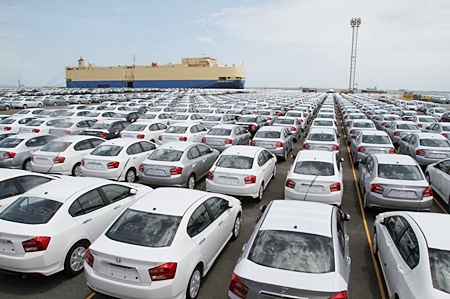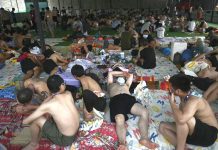A 120 billion baht expansion of Laem Chabang Port presented last week to Prime Minister Yingluck Shinawatra would increase cargo capacity enough for 20 years and connect the Chonburi harbor to Myanmar’s main port.
Transport Minister Charupong Ruangsuwan outlined the three-year project, which calls for construction of a third wharf and twin rail tracks to connect to the northeast, during the premier’s visit to the port June 18. Yingluck will now consider how much funding the plan gets in the coming year’s budget.
 Prime Minister Yingluck Shinawatra visits Laem Chabang Port to listen to expansion plans.
Prime Minister Yingluck Shinawatra visits Laem Chabang Port to listen to expansion plans.
Previously expanded twice, Laem Chabang now handles the equivalent of 5.6 million 20-foot containers a year. If the third phase is fully built out, the harbor could hand up to 18.8 million containers. Port Managing Director Chalermkiat Salukkum estimated traffic would increase to around 10 million containers after 2013, maxing out the harbor’s current capacity.
Under the expansion plan, a new 2 km wharf would be constructed. At 900 m. wide and 15 m. deep, the pier would be able to serve large vessels directly. However, the new pier will require land reclamation and officials need to gain the agreement of neighbors already agitated over traffic congestion and environmental impact of nearby industrial estates.
Three Chonburi committees are currently conducting environmental impact reports, but environmental groups are already aligning to oppose the project.
Business leaders, however, see port expansion as essential, not only to handle growing imports and exports, but lower costs as well. Poor roads and a lack of rail connections pose competitive disadvantages to the ports and cost shippers more.
The expansion calls for twin railway tracks to connect the port to Kaeng Khoi District in Saraburi province and Chachoengsao Province. It also includes expanding 2.6 km. of connecting roads from four lanes to six, extending an expressway to Laem Chabang and the construction of additional gates and billing stations.
Another key part of the plan is to connect Laem Chabang with the Burmese deep-water port of Dawei, where Thai companies are planning to populate a new industrial estate. Steel, coal and other raw materials could be sent from Myanmar while Thai exports bound for Europe could be transshipped in Myanmar for faster delivery. Currently, virtually all Laem Chabang export traffic is transshipped in Singapore, Malaysia or Hong Kong.
Opponents to the expansion will undoubtedly cite cargo growth statistics in their battle against expansion. Laem Chabang port has grown only 5.7 percent so far this year and passenger traffic has been up less than a percent. Automobile exports are also down dramatically. Port officials cited last year’s floods as the reason behind the slower trade.
Containerized imports and exports, however, are up about 38 percent.









